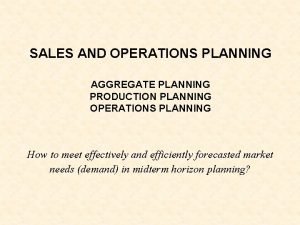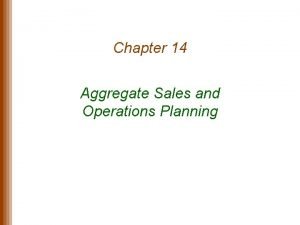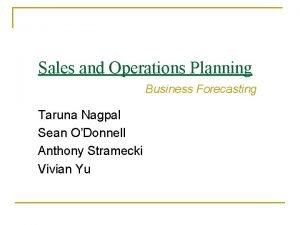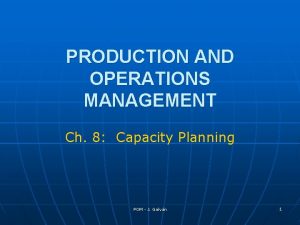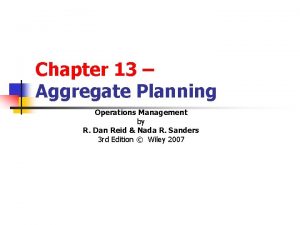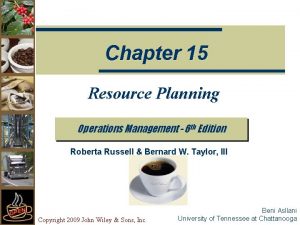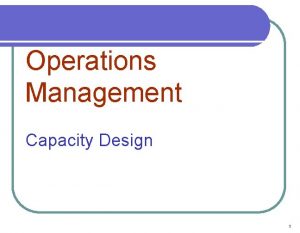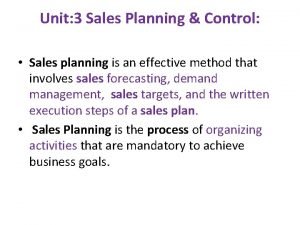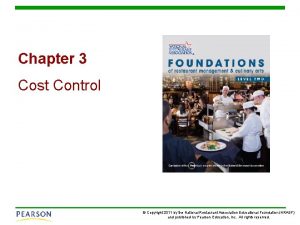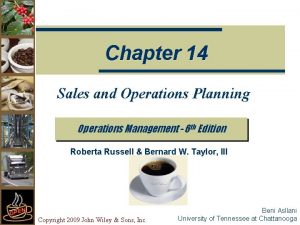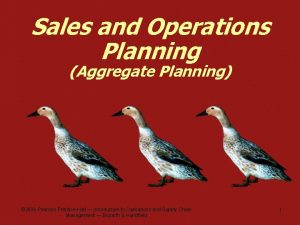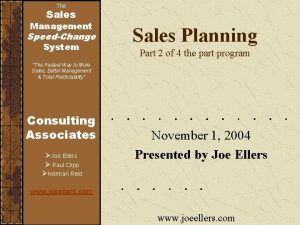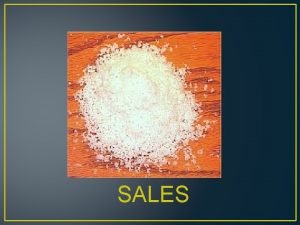Chapter 14 Sales and Operations Planning Operations Management






























- Slides: 30

Chapter 14 Sales and Operations Planning Operations Management - 6 th Edition Roberta Russell & Bernard W. Taylor, III Copyright 2009 John Wiley & Sons, Inc. Beni Asllani University of Tennessee at Chattanooga

Lecture Outline w The Sales and Operations Planning Process w Strategies for Adjusting Capacity w Strategies for Managing Demand w Quantitative Techniques for Aggregate Planning w Hierarchical Nature of Planning w Aggregate Planning for Services Copyright 2009 John Wiley & Sons, Inc. 2

Sales and Operations Planning w Determines the resource capacity needed to meet demand over an intermediate time horizon n n Aggregate refers to sales and operations planning for product lines or families Sales and Operations planning (S&OP) matches supply and demand w Objectives n n Establish a company wide game plan for allocating resources Develop an economic strategy for meeting demand Copyright 2009 John Wiley & Sons, Inc. 3

Sales and Operations Planning Process Copyright 2009 John Wiley & Sons, Inc. 4

Meeting Demand Strategies w Adjusting capacity n n Resources necessary to meet demand are acquired and maintained over the time horizon of the plan Minor variations in demand are handled with overtime or under-time w Managing demand n Proactive demand management Copyright 2009 John Wiley & Sons, Inc. 5

Strategies for Adjusting Capacity w Level production n Producing at a constant rate and using inventory to absorb fluctuations in demand w w Chase demand n Hiring and firing workers to match demand w Peak demand n w Overtime and under-time Maintaining resources for high-demand levels n Subcontracting n Let outside companies complete the work w Part-time workers n Hiring part time workers to complete the work w Backordering n Copyright 2009 John Wiley & Sons, Increasing or decreasing working hours Providing the service or product at a later time period 6

Level Production Demand Units Production Time Copyright 2009 John Wiley & Sons, Inc. 7

Chase Demand Units Production Time Copyright 2009 John Wiley & Sons, Inc. 8

Strategies for Managing Demand w Shifting demand into other time periods n n n Incentives Sales promotions Advertising campaigns w Offering products or services with countercyclical demand patterns w Partnering with suppliers to reduce information distortion along the supply chain Copyright 2009 John Wiley & Sons, Inc. 9

Quantitative Techniques For AP w w w Pure Strategies Mixed Strategies Linear Programming Transportation Method Other Quantitative Techniques Copyright 2009 John Wiley & Sons, Inc. 10

Pure Strategies Example: QUARTER Spring Summer Fall Winter SALES FORECAST (LB) 80, 000 50, 000 120, 000 150, 000 Hiring cost = $100 per worker Firing cost = $500 per worker Inventory carrying cost = $0. 50 pound per quarter Regular production cost per pound = $2. 00 Production per employee = 1, 000 pounds per quarter Beginning work force = 100 workers Copyright 2009 John Wiley & Sons, Inc. 11

Level Production Strategy Level production (50, 000 + 120, 000 + 150, 000 + 80, 000) = 100, 000 pounds 4 QUARTER Spring Summer Fall Winter SALES FORECAST 80, 000 50, 000 120, 000 150, 000 PRODUCTION PLAN INVENTORY 100, 000 400, 000 Cost of Level Production Strategy (400, 000 X $2. 00) + (140, 00 X $. 50) = $870, 000 Copyright 2009 John Wiley & Sons, Inc. 20, 000 70, 000 50, 000 0 140, 000 12

Chase Demand Strategy QUARTER SALES PRODUCTION FORECAST PLAN Spring Summer Fall Winter 80, 000 50, 000 120, 000 150, 000 WORKERS NEEDED HIRED FIRED 80 50 120 150 0 0 70 30 20 30 0 0 100 50 Cost of Chase Demand Strategy (400, 000 X $2. 00) + (100 x $100) + (50 x $500) = $835, 000 Copyright 2009 John Wiley & Sons, Inc. 13

Level Production with Excel Copyright 2009 John Wiley & Sons, Inc. 14

Chase Demand with Excel Copyright 2009 John Wiley & Sons, Inc. 15

Mixed Strategy w Combination of Level Production and Chase Demand strategies w Examples of management policies n n no more than x% of the workforce can be laid off in one quarter inventory levels cannot exceed x dollars w Many industries may simply shut down manufacturing during the low demand season and schedule employee vacations during that time Copyright 2009 John Wiley & Sons, Inc. 16

Mixed Strategies with Excel Copyright 2009 John Wiley & Sons, Inc. 17

Mixed Strategies with Excel (cont. ) Copyright 2009 John Wiley & Sons, Inc. 18

General Linear Programming (LP) Model w LP gives an optimal solution, but demand costs must be linear w Let n n n Wt = workforce size for period t Pt =units produced in period t It =units in inventory at the end of period t Ft =number of workers fired for period t Ht = number of workers hired for period t Copyright 2009 John Wiley & Sons, Inc. 19

LP MODEL Minimize Z = $100 (H 1 + H 2 + H 3 + H 4) + $500 (F 1 + F 2 + F 3 + F 4) + $0. 50 (I 1 + I 2 + I 3 + I 4) + $2 (P 1 + P 2 + P 3 + P 4) Subject to Demand constraints Production constraints Work force constraints P 1 - I 1 + P 2 - I 2 + P 3 - I 3 + P 4 - I 4 1000 W 1 1000 W 2 1000 W 3 1000 W 4 100 + H 1 - F 1 W 1 + H 2 - F 2 W 2 + H 3 - F 3 W 3 + H 4 - F 4 Copyright 2009 John Wiley & Sons, Inc. = 80, 000 = 50, 000 = 120, 000 = 150, 000 = P 1 = P 2 = P 3 = P 4 = W 1 = W 2 = W 3 = W 4 (1) (2) (3) (4) (5) (6) (7) (8) (9) (10) (11) (12) 20

Setting up the Spreadsheet Copyright 2009 John Wiley & Sons, Inc. 21

The LP Solution Copyright 2009 John Wiley & Sons, Inc. 22

Hierarchical Nature of Planning Items Production Planning Capacity Planning Resource Level Product lines or families Sales and Operations Plan Resource requirements plan Plants Individual products Master production schedule Rough-cut capacity plan Critical work centers Components Material requirements plan Capacity requirements plan All work centers Manufacturing operations Shop floor schedule Input/ output control Individual machines w Disaggregation: process of breaking an aggregate plan into more detailed plans Copyright 2009 John Wiley & Sons, Inc. 23

Collaborative Planning w Sharing information and synchronizing production across supply chain w Part of CPFR (collaborative planning, forecasting, and replenishment) n involves selecting products to be jointly managed, creating a single forecast of customer demand, and synchronizing production across supply chain Copyright 2009 John Wiley & Sons, Inc. 24

Rule Based ATP Product Request Yes Is the product available at this location? No Available-to -promise Yes Is an alternative product available at this location? No Allocate inventory Yes Is this product available at a different location? No Copyright 2009 John Wiley & Sons, Inc. Is an alternative product available at an alternate location? Yes No Allocate inventory Capable-topromise date Is the customer willing to wait for the product? No Available-to -promise Yes Revise master schedule Trigger production Lose sale 25

Aggregate Planning for Services 1. 2. 3. 4. Most services cannot be inventoried Demand for services is difficult to predict Capacity is also difficult to predict Service capacity must be provided at the appropriate place and time 5. Labor is usually the most constraining resource for services Copyright 2009 John Wiley & Sons, Inc. 26

Yield Management Copyright 2009 John Wiley & Sons, Inc. 27

Yield Management (cont. ) Copyright 2009 John Wiley & Sons, Inc. 28

Yield Management: Example NO-SHOWS PROBABILITY P (N < X ) 0 1 2 3 . 15. 25. 30 . 00. 15. 40. 70 . 517 Optimal probability of no-shows P(n < x) Cu 75 = =. 517 Cu + Co 75 + 70 Hotel should be overbooked by two rooms Copyright 2009 John Wiley & Sons, Inc. 29

Example: Perishable Inventory w Selling Price: $12. 95/unit C u= w Cost: $5/unit C o= w Salvage Value: $0. 50/unit Demand Probability 75, 000 0. 15 80, 000 0. 25 85, 000 0. 30 90, 000 0. 20 95, 000 0. 10 Copyright 2009 John Wiley & Sons, Inc. P(n<X) 30
 Sales and operation planning in sap
Sales and operation planning in sap Planning techniques
Planning techniques Aggregate sales and operations planning
Aggregate sales and operations planning Sales and operations planning certification
Sales and operations planning certification Location planning in operations management
Location planning in operations management Global retailing strategies
Global retailing strategies Salesforce sales organization structure
Salesforce sales organization structure Discuss the nuances of sales letters.
Discuss the nuances of sales letters. Sales organization structure and sales force deployment
Sales organization structure and sales force deployment Management of sales territories and quotas
Management of sales territories and quotas Chapter 12 inventory management
Chapter 12 inventory management System capacity definition in operations management
System capacity definition in operations management Capacity planning in operations management
Capacity planning in operations management Mrp in operations management
Mrp in operations management Aggregate planning operations management
Aggregate planning operations management Location planning management
Location planning management Resource planning in operations management
Resource planning in operations management Design capacity in operations management
Design capacity in operations management Sales force composite
Sales force composite Sales management & selling management
Sales management & selling management Sales budget
Sales budget Management chapter 5 planning and decision making
Management chapter 5 planning and decision making Chapter 3 strategic management
Chapter 3 strategic management Chapter 16 money management and financial planning
Chapter 16 money management and financial planning What are some characteristics of a wise money manager
What are some characteristics of a wise money manager Options-based planning
Options-based planning Which is the primary sales tool in most operations
Which is the primary sales tool in most operations Sales operations organizational structure
Sales operations organizational structure Four steps of planning a sales call
Four steps of planning a sales call Operations and quality management
Operations and quality management Operations management with total quality management book
Operations management with total quality management book

